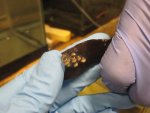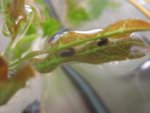They are in 20 gallon longs with no substrate. Each tank has two "snake hides" - black plastic hides weighed down with a piece of limestone. Each tank also has 4-5 plastic aquarium plants in it. I added some live plants yesterday and I'll let you know what they seem to prefer. No one has attached any eggs to the Anacharis though, plastic or live. I put a floating piece of cork in each tank, but I've never seen anyone use it. No lighting on the tanks, only the room light on a 10 - 14 hour cycle. Each tank has a sponge filter. I test the water quality twice weekly. Ammonia and nitrite usually are at zero or close to it, pH runs about 7.75 - 7.90. I feed them twice a week, sometimes three times. Nightcrawlers, red wigglers, krill, salmon pellets. They eat like rabid Bulldogs - always hungry.
Our vet treated them with Panacur (fenbendazole) orally. One treatment and then repeated in 14 days. Michael, I am fairly certain we got ours from the same place around the same time. We have some stuff from you here too - I am in Dubuque, Iowa. I'll try to post more pictures soon. Since ours just started laying I am guessing others will be close behind.



